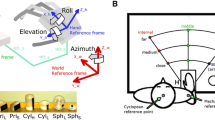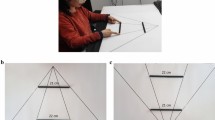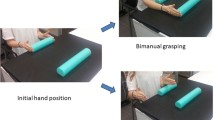Abstract
Previous evidence based on perceptual integration and arbitrary responses suggests extensive cross-modal links in attention across the various modalities. Attention typically shifts to a common location across the modalities, despite the vast differences in their initial coding of space. An issue that remains unclear is whether or not these effects of multisensory coding occur during more natural tasks, such as grasping and manipulating three-dimensional objects. Using kinematic measures, we found strong effects of the diameter of a grasped distractor object on the aperture used to grasp a target object at both coincident and non-coincident locations. These results suggest that interference effects can occur between proprioceptive and visuomotor signals in grasping. Unlike other interference effects in cross-modal attention, these effects do not depend on the spatial relation between target and distractor, but occur within an object-based frame of reference.




Similar content being viewed by others
Notes
On the other hand, this spatial redundancy effect seems to occur only when the stimuli to be discriminated are primarily represented in different cerebral hemispheres. Zampini et al. (2003) found that temporal order judgements do not depend on spatial separation when both are presented in one hemifield, while identical separations, which span the midline facilitate temporal order judgement.
References
Bell AHM, Meredith A, Van Opstal AJ, Munoz DP (2005) Cross-modal integration in the primate superior colliculus underlying the preparation and initiation of saccadic eye movements. J Neurophysiol 93:3659–3673
Castiello U (1996) Grasping a fruit: selection for action. J Exp Psychol Hum Percept Perform 22:582–603
Castiello U (1999) Mechanisms of selection for the control of hand action. Trends Cogn Sci 7:264–271
Castiello U (2005) The neuroscience of grasping. Nat Rev Neurosci 6:726–736
D’Amico M, Ferrigno G (1992) Comparison between the more recent techniques for smoothing and derivative assessment in biomechanics. Med Biol Eng Comput 30:193–204
Driver J, Spence C (1999) Cross-modal links in spatial attention. In: Humphreys GW, Duncan J, Treisman A (eds) Attention, Space and Action. Oxford University Press, Oxford, pp 130–149
Duncan J (1984) Selective attention and the organisation of visual information. J Exp Psychol Gen 113:501–517
Gentilucci M, Castiello U, Corradini ML, Scarpa M, Umilta’ C, Rizzolatti G (1991) Influence of different types of grasping on the transport component of prehension movements. Neuropsychologia 29:361–378
Gentilucci M, Daprati E, Gangitano M (1998) Haptic information differentially interferes with visual analysis in reaching-grasping control and in perceptual processes. Neuroreport 9:887–891
Graziano MS,Gross CG (1993) A bimodal map of space: somatosensory receptive fields in the macaque putamen with corresponding visual receptive fields. Exp Brain Res 97:96–109
Haggard P, Wing A (1995) Coordination of hand aperture with the spatial path of hand transport. Exp Brain Res 118:286–292
Huer H, Spijkers W, Kleinsorge T, van der Loo H, Steglich C (1998) The time course of cross-talk during the simultaneous specification of bimanual movement amplitudes. Exp Brain Res 118:381–392
Jakobson LS, Goodale MA (1991) Factors affecting higher-order movement planning: a kinematic analysis of human prehension. Exp Brain Res 86:199–208
Jeannerod M (1981) Intersegmental coordination during reaching at natural visual objects. In: Long J, Baddeley A (eds) Attention and performance IX Erlbaum. Hillsdale, NJ, pp 153–169
Jeannerod M (1984) The timing of natural prehension movements. J Motor Behav 16:235–254
Jeannerod M, Frak V (1999) Mental imaging of motor activity in humans. Curr Opin Neurobiol 9:735–739
Kelso JAS, Southard DL, Goodman D (1979) On the coordination of two-handed movements. J Exp Psychol Hum Percept Perform 5:229–238
Marr D (1982) Vision. W. H. Freeman, San Francisco
Patchay S, Castiello U, Haggard P (2003) A cross-modal interference effect in grasping objects. Psychonom Bull Rev 10:924–931
Pouget A, Ducom JC, Torri J, Bavelier D (2002) Multisensory spatial representations in eye-centered coordinates for reaching. Cognition 83:1–11
Scholl BJ (2001) Objects and attention: the state of the art. Cognition 80:1–46
Spence C, Pavani F, Driver J (1998) Cross-modal links between vision and touch in covert endogenous spatial attention. J Exp Psychol Hum Percept Perform 26:1298–1319
Spence C, Baddeley R, Zampini M, James R, Shore DI (2003) Multisensory temporal order judgments: when two locations are better than one. Percept Psychophys 65:318–328
Spence CJ, Driver J (1996) Audiovisual links in endogenous covert spatial attention. J Exp Psychol Hum Percept Perform 22:1005–1030
Stein BE (1998) Neural mechanisms for synthesizing sensory information and producing adaptive behaviors. Exp Brain Res 123:124–135
Tipper SP, Howard LA, Jackson SR (1997) Selective reaching to grasp: evidence for distractor interference effects. Vis Cogn 4(1):1–38
Tipper SP, Howard LA, Houghton G (1998) Action-based mechanisms of attention. Philos Trans R Soc Lond B, Biol Sci 353:1385–1393
Welsh TN, Elliott D (2004) Movement trajectories in the presence of a distracting stimulus: Evidence for a response activation model of selective reaching. Q J Exp Psychol Sect A 57:1031–1057
Westwood DA, Goodale MA (2003) Perceptual illusion and the real-time control of action. Spat Vis 16:243–254
Wing AM, Turton A, Fraser C (1986) Grasp size and accuracy of approach in reaching. J Mot Behav 18:245–260
Wing AM, Church RM, Gentner RD (1989) Variability of the timing of responses during repetitive tapping with alternate hands. Psychol Res 51:28–37
Yamamoto S, Kitazawa S (2001) Reversal of subjective temporal order due to arm crossing. Nat Neurosci 4:759–765
Zampini M, Shore DI, Spence C (2003) Multisensory temporal order judgments: the role of hemispheric redundancy. Int J Psychophys 50:165–180
Acknowledgements
This work was supported by the Fondation Singer Polignac, Paris and the Wellcome Trust.
Author information
Authors and Affiliations
Corresponding author
Rights and permissions
About this article
Cite this article
Patchay, S., Haggard, P. & Castiello, U. An object-centred reference frame for control of grasping: effects of grasping a distractor object on visuomotor control. Exp Brain Res 170, 532–542 (2006). https://doi.org/10.1007/s00221-005-0240-6
Received:
Accepted:
Published:
Issue Date:
DOI: https://doi.org/10.1007/s00221-005-0240-6




